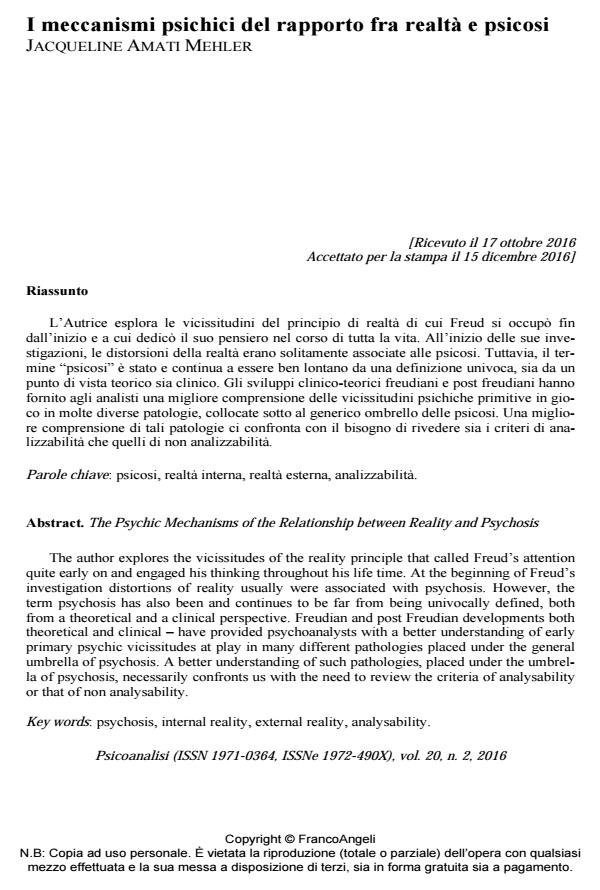I meccanismi psichici del rapporto fra realtà e psicosi
Titolo Rivista PSICOANALISI
Autori/Curatori Jacqueline Amati Mehler
Anno di pubblicazione 2017 Fascicolo 2016/2
Lingua Italiano Numero pagine 19 P. 5-23 Dimensione file 220 KB
DOI 10.3280/PSI2016-002001
Il DOI è il codice a barre della proprietà intellettuale: per saperne di più
clicca qui
Qui sotto puoi vedere in anteprima la prima pagina di questo articolo.
Se questo articolo ti interessa, lo puoi acquistare (e scaricare in formato pdf) seguendo le facili indicazioni per acquistare il download credit. Acquista Download Credits per scaricare questo Articolo in formato PDF

FrancoAngeli è membro della Publishers International Linking Association, Inc (PILA)associazione indipendente e non profit per facilitare (attraverso i servizi tecnologici implementati da CrossRef.org) l’accesso degli studiosi ai contenuti digitali nelle pubblicazioni professionali e scientifiche
L’Autrice esplora le vicissitudini del principio di realtà di cui Freud si occupò fin dall’inizio e a cui dedicò il suo pensiero nel corso di tutta la vita. All’inizio delle sue investigazioni, le distorsioni della realtà erano solitamente associate alle psicosi. Tuttavia, il termine "psicosi" è stato e continua a essere ben lontano da una definizione univoca, sia da un punto di vista teorico sia clinico. Gli sviluppi clinico-teorici freudiani e post freudiani hanno fornito agli analisti una migliore comprensione delle vicissitudini psichiche primitive in gioco in molte diverse patologie, collocate sotto al generico ombrello delle psicosi. Una migliore comprensione di tali patologie ci confronta con il bisogno di rivedere sia i criteri di analizzabilità che quelli di non analizzabilità.
Parole chiave:Psicosi, realtà interna, realtà esterna, analizzabilità
- Amati Mehler J. (2000a). Psicoanalisi: teoria e tecnica oggi. Psicoanalisi, 4, 1: 39.
- Amati Mehler J. (2000b). Das Ich gestern und heute. In: Das Ich – eine vernachlässigte Instanz? Tagungsband der DPV-Arbeitstagung vom 1.-4. München: Wolfgang-Loch-Stigtung.
- Amati Mehler J. (2001). L’Io ieri e oggi. Psicoanalisi, 5, 2: 139.
- Amati Mehler J., Argentieri S., Canestri J., (1993 [2010]). Das Babel des Umbewussten: Muttersprache und Fremdsprachen in der Psychoanalyse. Giessen: Psychosozial-Verlag.
- Amati Mehler J. (2004). Mélancolie: folie, génie ou tristesse? Les vicissitudes de l’identification et de la formation du moi. Rev. franç. Psychanal., 4: 334.
- Arlow J. A., Brenner C. (1969). The Psychopathology of the Psychoses: A Proposed Revision. Int. J. Psycho-Anal., 50: 5.
- Bleger J. (1973). Simbiosis y Ambiguidad. Buenos Aires: Paidos (trad. it. Simbosi e ambiguità. Roma: Armando, 2010).
- Bleuler. E (1911). Dementia Praecox, oder Gruppe der Schizophrenien. Leipzig - Vienna: Deuticke.
- Canestri, J. (1993). Il Soggetto Polilogico. In: Ri-Scritture. Torino: Eurelle Edizioni.
- Eissler K. R. (1953). The Effect of the Structure of the Ego on Psychoanaytic Technique. IJPA 1, 1: 104-143.
- Freud S. (1892-1894). Le neuropsicosi da difesa. In: Opere, vol. 2. Torino: Boringhieri, 1968).
- Freud S. (1893-1895). Studi sull’isteria. In: Opere, vol. 2. Torino: Boringhieri, 1968.
- Freud S. (1909). Some General Remarks on Hysterical Attacks. In: SE, IX, pp. 231-232.
- Freud S. (1923). L’organizzazione genitale infantile. In: Opere, vol. 9. Torino: Boringhieri, 1977.
- Freud S. (1923). L’Io e l’Es. In: Opere, vol. 9. Torino: Boringhieri, 1977.
- Freud S. (1924). Nevrosi e psicosi. In: Opere, vol. 9. Torino: Boringhieri, 1977.
- Freud S. (1924). La Perdita di realtà nella nevrosi e nella psicosi. In: Opere, vol. 10. Torino: Boringhieri, 1978.
- Freud S. (1929). Il disagio della civiltà. In: Opere, vol. 10. Torino: Boringhieri, 1978.
- Freud S. (1938). La scissione dell’Io nel processo di difesa. In: Opere, vol. 11. Torino: Boringhieri, 1979.
- Freud S. (1937). Analisi terminabile e interminabile. In: Opere, vol. 11. Torino: Boringhieri, 1979.
- Freud S. (1938). Compendio di psicoanalisi. In: Opere, vol. 11. Torino: Boringhieri, 1979.
- Freud S. (1950 [1887-1902]). Progetto di una psicologia. In: Opere, vol. 2. Torino: Boringhieri, 1968.
- Glover E. (1930). Grades of Ego Differentiation. IJPA, 11, 1: 1-11.
- Meltzer D. (1967). The Psychoanalytic Process. London: Heinemann (trad. it. Il processo psicoanalitico. Roma: Armando, 1971).
- Modell A. H. (1975). The Ego and the Id: Fifty Years Later. IJPA, 56,1: 57-68.
- Rosenfeld H. (1958). Discussion on Ego Distortion. IJPA, 39, 2: 274-275.
- Sandler J. (1976). Countertransference and role responsiveness. Int. Rev. Psychoanal., 3: 43-47.
- Sandler J. (1993). On Communication from Patient to Analyst: Not everything is projective identification. IJPA, 74, 6: 1097-1107.
- Segal H., Britton R. (1981). Interpretation and Primitive Psychic Processes: A Kleinian View. Psychoanal. Inq., 1: 267-277.
- Schafer R. (2007). The Reality Principle, Tragic Knots, and the Analytic Process. JAPA, 55, 4: 1151. DOI: 10.1177/000306510705500403
Jacqueline Amati Mehler, I meccanismi psichici del rapporto fra realtà e psicosi in "PSICOANALISI" 2/2016, pp 5-23, DOI: 10.3280/PSI2016-002001